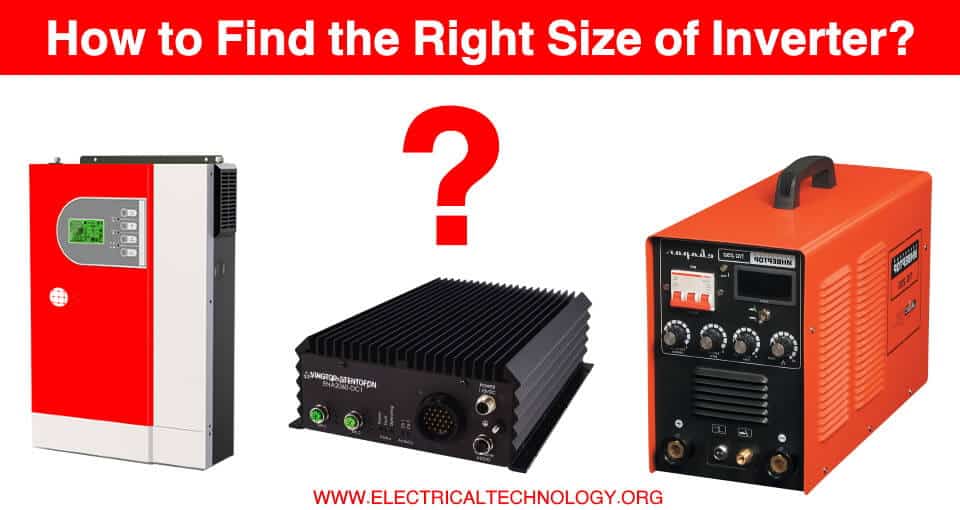How to Determine the Suitable Size of Inverter for Home Appliances?
How Much Watts Inverter/UPS Do You Need for Home Appliances? Solved Example
A power inverter is a device that converts DC supply to AC supply. Most household appliances are designed to operate on AC supply (120V or 240V in the US and 230V in the UK and EU). That’s why we need an appropriately sized inverter to run and handle the AC load and appliances in case of an emergency or electricity failure.
As DC supply is available from different sources such as batteries, solar panels, portable generators, we can convert the DC power into AC power using inverters to run 120V or 230/240V appliances. To do this, we need to find the suitable size of inverter and batteries based on the required load in watts.
A power inverter is always rated in VA (Volt-Amps), but we assume its rating in watts based on the appliances’ wattage rating. The following example will illustrate the difference between the VA and wattage ratings of inverters based on our required wattage.
Related Posts:
- How Much Watts Solar Panel Do You Need for Home Appliances?
- Basic Components Needed for Solar Panel System Installation
How to Calculate & Choose the Right Sized Inverter / UPS?
The following step-by-step example demonstrates how to determine and select a properly rated inverter or UPS (Uninterruptible Power Supply) for home and office appliances:
Example:
Calculate the proper rating of an inverter for the following home appliances.
- 3 No. of Fans: 3 x 80W = 240W
- 4 No. of LED Light: 4 x 15W = 60W
- 1 No. of LCD TV: 120W
- 1 No. of Laptop: 110W
- 1 No. of Laser Printer: = 60W
- 2 No. of Cell Phone Charger: 2 x 25W = 50W
Solution:
Step 1:
First of all, calculate the total required power in watts as follows.
240W + 60W + 120W + 110W + 60W + 50W = 650W
| Appliance | Quantity | Wattage |
| Fan (80W) | 3 | 240W |
| LED Light (15W) | 4 | 60W |
| LCD TV (120W) | 1 | 120W |
| Laptop (110W) | 1 | 110W |
| Laser Printer (60W) | 1 | 60W |
| Phone Charger (25W) | 2 | 50W |
| Total Load | 640W | |
Related Posts:
- How to Design and Install a Solar PV System? With Solved Example
- A Complete Guide about Solar Panel Installation. Step by Step Procedure with Calculation & Diagrams
Step 2:
Ideally, you need a 650W inverter for 650W load points but this is not possible in real life as there are multiple factors which affect the overall efficiency of the inverter. As there is no such a 100% efficient inverter due to some losses in it as well as the role of power factor. This is where we should know about the VA rating of the inverter.
Generally, we consider 70%-80% efficiency of the inverter (if not mentioned on the nameplate or user manual from the manufacturer). To find the VA (Volt x Amp) rating of the inverter, we divide the calculated wattage rating on inverter efficiency or power factor. Consider the following two basic formulas
- Power in Watts = Volts x Amp
- Power in VA = Volt x Amp x Power Factor (Efficiency)
- Power in VA = Wattage ÷ Power Factor (Efficiency)
By using the third formula (as applicable), we find the apparent power of the inverter as follows
Power in VA = Wattage ÷ Power Factor (Efficiency)
Power in VA = 640W ÷ 0.8 = 800 Watts.
Based on this calculation, we need a minimum of 800W inverter to handle 640W load appliances.
Related Posts:
- How to Calculate the Battery Charging Time & Battery Charging Current?
- How to Connect Automatic UPS / Inverter to the Home Supply System?
Step 3:
As a final touch, we add the future expansion (safety factor) as 1.25 to the calculated wattage. This way, we will be able to put some additional load on the inverter in future (if needed). In addition, it will protect the inverter from voltage spikes and power surges. To do so, simply multiply the calculated wattage by 1.25 to calculate the appropriate size of inverter rating in watts.
Right Size Inverter = 800 W x 1.25 = 1000 Watts
This is the most suitable size of inverter e.g. a 1000 Watts inverter will handle a 640W load safely and smoothly.
Related Posts:
- How to Calculate the Right Size of Solar Charge Controller?
- PWM Solar Charge Controller – Working, Sizing and Selection
- MPPT Solar Charge Controller – Working, Sizing and Selection
- How to Determine the Number of Circuit Breakers in a Panelboard?
- How to Determine the Right Size Capacity of a Subpanel?
- American Wire Gauge “AWG” Chart – Wire Size & Ampacity Table
- How to Find the Proper Size of Circuit Breaker? Breaker Calculator & Examples
- How to Find The Suitable Size of Cable & Wire ? – Solved Examples
- How to Find Voltage & Ampere Rating of Switch, Plug, Outlet & Receptacle
- How to Find the Number of Outlets on a Single Circuit Breaker?
- How to Find the Number of Lights on a Single Circuit Breaker?








Trevor linsley